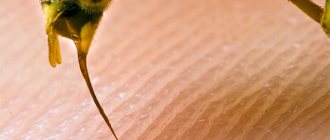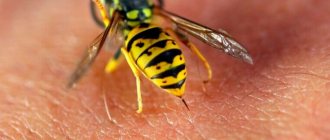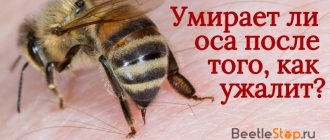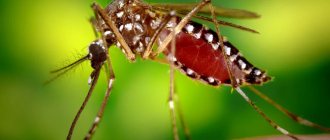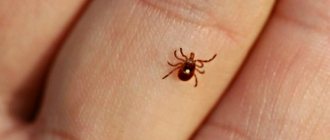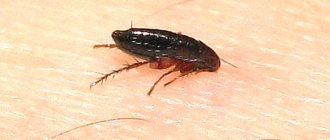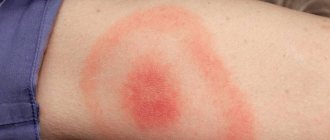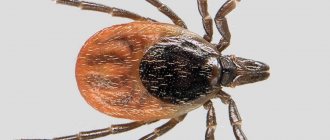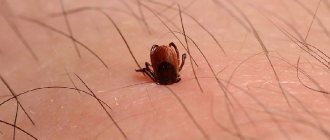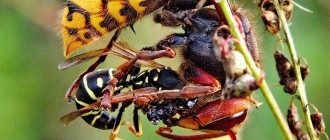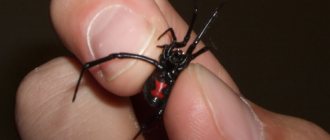When enjoying ripe fruits in the summer, you should be careful. The sweet taste attracts a variety of insects, including bees and wasps.
Wasp stings are accompanied by pain, redness and swelling, which gives a similarity to the picture after being attacked by bees. After receiving several bites, a toxic reaction may develop. The following will describe how many times a bee bites, how many times one wasp can sting, and what can be done as first aid after a sting.
Number of stings from one wasp
How many times can a wasp sting? Unlike the sting of bees, the sting of wasps does not have serrations, which allows individuals to sting the enemy several times without causing harm to themselves. Being predators, wasps have developed jaws that can bite through the dense layer of chitin in the cover of other insects.
Wasp
The powerful oral apparatus allows individuals to bite without resorting to the action of a sting. Such a maneuver will cause inconvenience to a person, comparable to a sting. However, no toxic substances will be injected.
Do all bees sting?
Not all bees are capable of stinging. Drones have a physiological obstacle - they do not have a stinger. Since this is a modified ovipositor, which is not provided by nature for male bees. Yes, and not every bee with a stinger can sting.
On a note! Working individuals, whose crops are filled with honey, are not able to bend their abdomen at the required angle in order to extend the sting and put it to work.
Experienced beekeepers can protect themselves by artificially creating a situation in which the bee fills the crop with honey. Bees perceive fumigation of the hive as an alarm signal. Fleeing from the fire, they gather supplies so as not to starve until new housing is found.
Can a wasp sting several times?
How many times does a wasp bite? The anatomical features of wasps lie in the mechanism of action of the sting. At rest, it is hidden in the back of the wasp's body under the plates. When excited and in an aggressive state, the plates diverge, and the sting moves out of the body cavity along the guide muscles. How many times can a wasp sting? When attacking, the wasp can make several movements, each time throwing out a sting to introduce poison into the enemy’s body.
How long does a bee live?
Note! Unlike bees, the loss of a sting by a wasp will not lead to the death of the individual.
The structure of a wasp sting
If you take a magnifying glass, you can study the structure of the bite in more detail, although the naked eye can see that a sharp needle protrudes from the wasp’s body. Below, in the photo, you can see what a hornet bite looks like.
The appearance resembles a rather pointed element, inside of which there is a channel connected to a gland produced by poison. After a bite, the sting expands and some of the venom enters the wound.
In a normal state, the puncture is almost invisible, as it is pulled into the abdominal cavity and covered with protective plates. In case of aggression, the needle extends and performs its protective functions.
The surface of the wasp's sting is smooth, without serrations, so it easily pierces the victim's body and is just as easily removed from it.
Important point! The sting is transparent, although visually dark, almost black.
How dangerous is a wasp sting?
If the body systems are functioning normally and there is no allergic reaction, a wasp sting does not pose a threat to human life. However, developing symptoms of inflammation can be uncomfortable.
Wasp venom contains the following substances that cause negative effects on human health:
- phospholipases – enzymes that provoke inflammatory processes in tissues;
- melitin is an inducer of tissue breakdown;
- acetylcholine – causes a lack of coordination, affecting the nervous system;
- histamine is a component responsible for allergic manifestations;
- MCD-peptide - causes the breakdown of tissue cells, increasing the allergic reaction.
Can honey ferment?
Coloring
The coloring options for insects are so numerous that it is not difficult to distinguish between a bumblebee, a wasp and a bee. The bee is distinguished by dark brown shades. In cartoons, there is a certain stereotype, which is why honey collectors are drawn with stripes. If you look closely at the images of insects, their difference immediately catches your eye.
Bumblebees and wasps can have completely monotonous colors, including stripes. There are glossy wasps, which are distinguished by rainbow colors, and typhias, for example, are painted in a monotonous black color. However, most people believe that wasps have exclusively classic colors, with a predominance of yellow and black stripes. It should be noted that representatives of other families that do not have similar coloring can be dangerous and can bite just as painfully.
Symptoms and first aid
The first symptom of a wasp sting is acute, sharp pain in the affected area. Redness and swelling of the tissues develop within a few minutes. Despite the harmless manifestation, first aid measures should be taken immediately to prevent the development of anaphylactic shock.
Important! In any case, the initial help provided for a wasp bite is to take any antihistamine, after which you can proceed to the next steps.
The first step is to wash the damaged area of the body, removing any remaining dirt and toxic substances. To prevent the spread of poison, carefully remove the stuck sting with tweezers or a sharp needle. After this, the wound itself must be treated with any available disinfectant (alcohol, iodine solution, brilliant green, hydrogen peroxide, etc.).
Important! A wasp sting is accompanied by the production of stress hormones. To reduce the level of excitement of the nervous system, it is recommended that the victim rest.
How to help at home?
If there are no medicines at hand, folk remedies that can be found in every home can help. By the way, natural remedies will also come in handy if a wasp has bitten a pregnant woman, for whom the list of approved medications is very limited. More often than others, the following are used to treat the bite site:
- aloe juice or pulp;
- a slurry of soda mixed with water;
- sour fruit (lemon, sour blocks);
- diluted apple cider vinegar;
- tomato pulp (both ripe and green);
- grated fresh potatoes.
Grated potatoes
Some housewives advise adding chopped onion or garlic, but the juice of these plants is very caustic, so the method is not suitable for everyone. In particular, such lotions are not recommended for treating wasp stings during pregnancy
Treatment and consequences after a bite
You can speed up relief from the consequences of a wasp sting by the following means:
- Drinking plenty of hot tea or sweetened water will speed up the removal of toxins from tissues;
- parsley leaves mashed into a paste will speed up the process of relieving swelling;
- to neutralize wasp venom, you can treat the surface of the bite with lemon juice;
- A compress of vinegar or sorrel will help relieve pain;
- if you don’t have painkillers on hand, you can use dandelion juice;
- lotions made from aloe juice, onion or ice cube can speed up the relief of irritation and itching;
- a piece of sugar relieves swelling well;
- Calendula infusion will also relieve redness and discomfort.
The consequences of a wasp sting disappear on their own within a couple of days. If swelling does not decrease, you should seek medical help.
Multiple bites can cause subcutaneous hemorrhage, leading to extensive hematomas.
The hardest bite is on the tissues of the face. The consequences of a bite to the eyebrow can be severe swelling of the eyelid and swelling of the eye. In the worst case scenario, acuity may decrease or vision loss may occur.
If the tongue or nose is damaged, severe swelling develops, interfering with normal breathing. The consequence of a tongue injury may be a decrease in taste perception.
When bitten on the scalp, it becomes difficult to remove the sting from the tissue. The sting left behind provokes a reaction of the local immune system, attracting leukocytes to the wound. The inability of immune system cells to get rid of a foreign body is expressed in their death and the appearance of suppuration. Such an abscess can break out on its own, accompanying the removal of the sting. The worst case scenario is extensive tissue suppuration, requiring surgical intervention.
If the sting is not removed, suppuration may occur.
A wasp sting in the urinary canal area can cause difficulty urinating. In severe cases, swelling can lead to blockage of the urinary tract.
An attack by many individuals can lead to death. It is known that the dose of one bite is 0.2 mg of poison. In a mass attack, a large number of individuals can bite. When 200 mg of toxins enter the human body, the functioning of the nervous, respiratory and cardiovascular systems is disrupted, leading to the death of the victim.
To summarize, we can say that wasp stings are unpleasant phenomena. In the absence of allergic reactions, the duration of negative consequences does not exceed several days. However, in cases of lesions near the respiratory or visual organs, negative consequences may develop in the form of difficulty breathing and loss of vision.
How many times can one wasp sting? Due to its anatomical features, one individual can strike several times, unlike bees. In this case, toxins can be injected each time until the reserves are completely depleted. An attack by a swarm of wasps can lead to death, since more than two hundred stings are considered a lethal dose.
The first aid after a wasp attack should be to take antihistamines. You can alleviate the symptoms of biting by resorting to folk recipes based on medicinal herbs and publicly available medications. In the absence of positive dynamics, you must immediately contact a medical facility.
In addition, unlike peaceful bees, wasps are considered an aggressive species. Therefore, when you see a wasp, it is better to try to avoid contact with it.
5 1 vote
Article rating
Degree of toxicity of the poison
Regardless of the type of wasp, the structure of the bite has identical characteristics, but the nature of the bite and the consequences depend on the toxicity of the poisonous secretion.
- The hornet is the largest wasp and will sting quite painfully. In addition, the hornet has a rather poisonous venom that can seriously harm human health. The Asian hornet kills an allergy-prone person in a matter of minutes. Hornet stings kill up to 50 people every year in countries such as Japan and China. The nature of the bite is comparable to the penetration of a hot nail into human skin. There are no such dangerous insects in our territories, but a person can die after 5 bites of such insects if timely assistance is not provided.
- Giant scoli are also among the largest wasps on the planet. It should be noted that their sting is small, and the venom is not toxic to humans. In the case of a scoliathus bite, short-term numbness of the bite site may occur for a few minutes. Only allergy sufferers or children who still have a weak immune system can suffer from such a bite. These insects are not aggressive, so they prefer not to participate in various conflict situations, even with people. In addition, colias are not considered social insects and do not live in large families, so they are not at risk of numerous insect bites.
- Streamers are one of the most harmless creatures representing the wasp family. They live deep in the earth, in holes they dug. These insects also have a second name - bee wolves, since adult individuals are capable of destroying bee colonies, since bees form the basis of their diet. The larva eats 5 bees to become an adult. As a rule, bee wolves attack their prey in flight, inserting a stinger into it, which leads to paralysis of the insects. After this, they eat their prey or take it to the nest. Benefactors live underground, easily finding their nest at any distance.
- Pompylids are wasps with a long sting and strong venom. Therefore, the bites of these wasps are quite painful. These insects are quite aggressive and attack at the slightest sign of aggression towards them. More than 150 species live on our territory. Adults grow up to 3 cm in length and lead a secluded life, without creating nests or large families. Eggs are laid on spiders. After birth, the larva eats the spider from the inside. The bite of these aggressive insects is quite powerful and strong.
It is very important to know what to do if a wasp does sting you. This is especially true for those people whose body reacts very violently to the action of insect venom, causing serious and sometimes fatal consequences.
Appearance of a hornet, its difference from a wasp
Since the hornet belongs to the wasp family (closer to the common ones), their appearance is largely similar. The main and most noticeable difference is the size of the hornets: they are almost 2 times larger than their “sisters”.
Their coloring is also different. Wasps have no shades of brown on their bodies: their predominant colors are yellow and black. Hornets always have a brown tint, mainly on the cephalothorax area. As members of the same family, they both have a characteristic thin waist (which bumblebees, which have a round and shaggy body, do not have), powerful jaws and large eyes. However, hornets and wasps have a noticeably different size and shape of the head: a large, wide nape and an almost round shape - this is characteristic of the hornet, while the wasp has a small head, slightly narrowed towards the base.
In the photo on the left is a hornet, on the right is a wasp
Hornets are often confused with the Scolia wasp, and this is not surprising: their sizes are approximately the same, since Scolia is very large. But if you look closely, you can see that their difference is not only in the shape of the head, but also in color. Scolia have a completely black head and cephalothorax, and on the same black abdomen there are 2 bright yellow stripes. The hornet's cephalothorax is closer to a brown-brown hue, and the stripes on the abdomen are not so bright.
